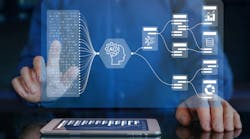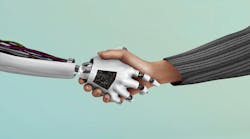The benefits, risks, and effective use of AI in dentistry
Artificial intelligence (AI) is reshaping industries across the board, and dentistry is no exception. While much of the conversation around AI in health care focuses on clinical improvements, AI is also beginning to influence the way dental practices manage their teams. Understanding both the benefits and risks of using AI in employment is critical to effectively harnessing its potential.
Benefits of AI
Recruiting the right talent can be time-consuming, especially with traditional recruitment that involves manually sifting through résumés, screening candidates, and coordinating interviews. AI tools are streamlining these processes and making them more efficient through automation. For example, AI-powered applicant tracking systems, such as Lever or Workable, can scan résumés, schedule interviews, and manage candidate communications.
Other AI tools, such as Greenhouse, have reshaped the onboarding experience by automating repetitive tasks, ensuring regulatory compliance, and enabling the user to personalize the experience for each new hire. These tools can increase efficiency and ensure consistency of information and training.
Software companies such as Lattice use AI to facilitate continuous performance management. They identify, set, and track goals, and perform check-ins and reviews, among other system features that connect performance, feedback, and career growth. AI can also automate administrative tasks such as time tracking, payroll calculations, and benefits administration, freeing up more time for practice owners to focus on strategic initiatives.
Risks of AI
AI algorithms can be biased, and a computational system based on flawed assumptions, biases, or instructions will produce flawed conclusions. This may lead to unfavorable impacts on a candidate or employee, which can trigger liability in a discrimination case. For example, a hiring algorithm constructed to favor (or disfavor) one protected group versus another constitutes unlawful disparate treatment discrimination.
Automated systems can unintentionally screen out a disproportionate number of protected class members. For example, if an AI tool identifies job candidates whose characteristics mirror those of the employer's star employees—all of whom happen to be men—the use of AI can disparately—and illegally—impact women.
AI processes an enormous amount of sensitive data that demands privacy and security. Data breaches, hacking, and cyberattacks can cause significant and lasting damage to businesses, employees, and patients. With AI, such risks are increased, and any breach could mean catastrophic consequences.
AI technologies have the potential for system errors, inaccurate predictions, and malfunctions. An AI system might produce output confidently, even if incorrect. Over-reliance on AI without humans providing the necessary supervision, interpretation, and ultimate decision-making responsibilities can lead to damaging repercussions.
Regulations for AI
Several states and cities have begun implementing laws aimed at regulating the use of AI in employment. New York City, Illinois, and California have all passed laws. Other states such as Washington and Massachusetts have introduced bills addressing these concerns, and it is almost certain other states will follow.
The federal Department of Labor published Artificial Intelligence and Worker Well-Being: Principles and Best Practices for Developers and Employers in October 2024. While not legally binding on employers, this document is intended to be a roadmap for employers “to harness AI technologies for their business while ensuring workers benefit from the new opportunities and are shielded from potential harms.”
Effective use of AI
Dentists should approach AI integration strategically. Here are a few tips for effective use:
- Start small: Implement AI in one or two areas, such as recruitment, before expanding its use across the practice. This allows for testing and adjusting systems without overwhelming the team.
- Choose AI vendors carefully: Ensure that the data used to train their algorithms is diverse and free from discriminatory patterns.
- Ensure privacy: Work closely with AI vendors to understand how data is being managed and ensure that robust cybersecurity measures are in place to protect sensitive information from breaches or unauthorized access.
- Comply with applicable federal, state, or local laws.
- Maintain a human touch: While AI can handle many tasks, certain decisions should always involve human input.
Conclusion
AI has the potential to revolutionize employment practices in dentistry, offering benefits such as greater efficiency and streamlined operations. However, it’s essential to be aware of the risks and approach AI integration thoughtfully. In doing so, dental practices can reap the rewards while ensuring that both employees and patients are well cared for.
Editor's note: This article appeared in the January 2025 print edition of Dental Economics magazine. Dentists in North America are eligible for a complimentary print subscription. Sign up here.
About the Author

Rebecca Boartfield, SHRM-SCP
Rebecca Boartfield, SHRM-SCP, is an HR compliance consultant for Bent Ericksen & Associates. For more than 40 years, the company has been a leading authority in human resources and personnel issues, helping dentists successfully deal with ever-changing and complex labor laws. To learn more, call (800) 679-2760 or visit bentericksen.com.


